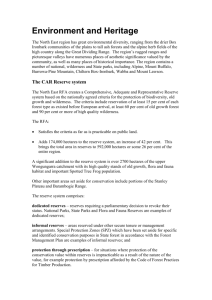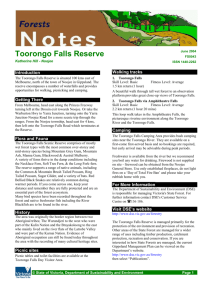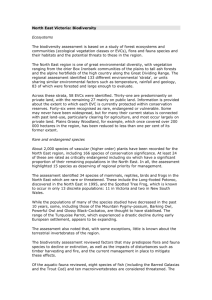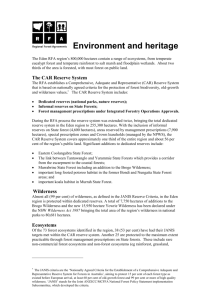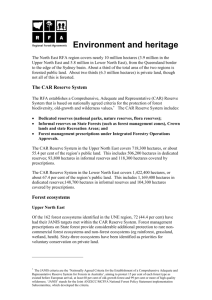The RFA and the Environment The RFA provides major benefits for
advertisement
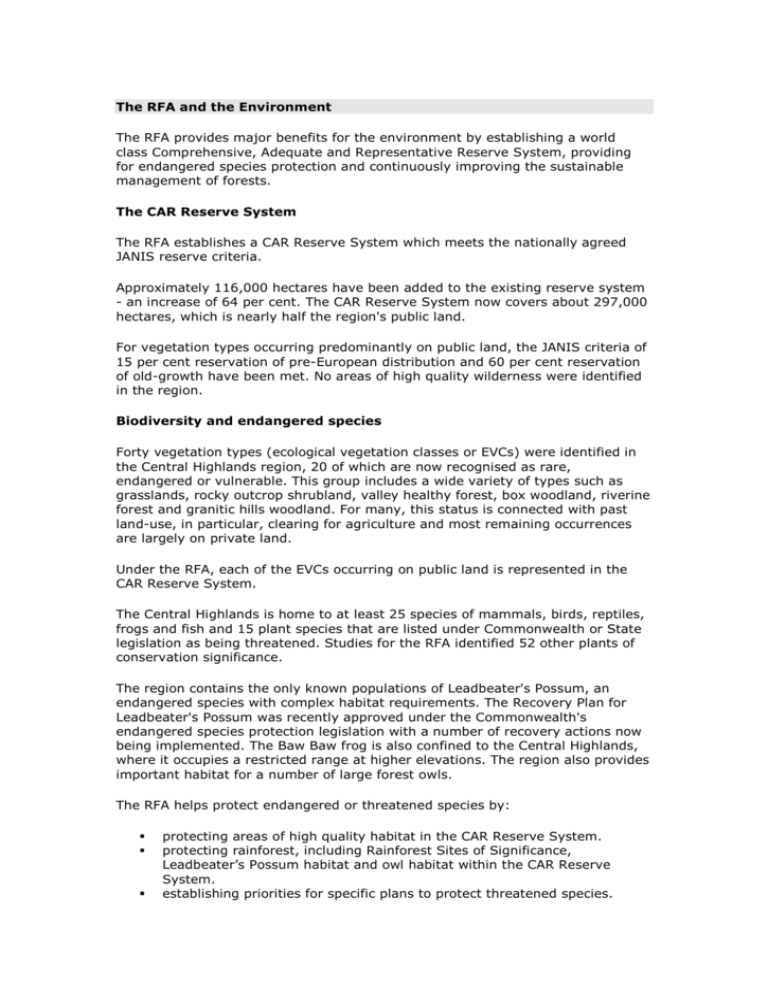
The RFA and the Environment The RFA provides major benefits for the environment by establishing a world class Comprehensive, Adequate and Representative Reserve System, providing for endangered species protection and continuously improving the sustainable management of forests. The CAR Reserve System The RFA establishes a CAR Reserve System which meets the nationally agreed JANIS reserve criteria. Approximately 116,000 hectares have been added to the existing reserve system - an increase of 64 per cent. The CAR Reserve System now covers about 297,000 hectares, which is nearly half the region's public land. For vegetation types occurring predominantly on public land, the JANIS criteria of 15 per cent reservation of pre-European distribution and 60 per cent reservation of old-growth have been met. No areas of high quality wilderness were identified in the region. Biodiversity and endangered species Forty vegetation types (ecological vegetation classes or EVCs) were identified in the Central Highlands region, 20 of which are now recognised as rare, endangered or vulnerable. This group includes a wide variety of types such as grasslands, rocky outcrop shrubland, valley healthy forest, box woodland, riverine forest and granitic hills woodland. For many, this status is connected with past land-use, in particular, clearing for agriculture and most remaining occurrences are largely on private land. Under the RFA, each of the EVCs occurring on public land is represented in the CAR Reserve System. The Central Highlands is home to at least 25 species of mammals, birds, reptiles, frogs and fish and 15 plant species that are listed under Commonwealth or State legislation as being threatened. Studies for the RFA identified 52 other plants of conservation significance. The region contains the only known populations of Leadbeater's Possum, an endangered species with complex habitat requirements. The Recovery Plan for Leadbeater's Possum was recently approved under the Commonwealth's endangered species protection legislation with a number of recovery actions now being implemented. The Baw Baw frog is also confined to the Central Highlands, where it occupies a restricted range at higher elevations. The region also provides important habitat for a number of large forest owls. The RFA helps protect endangered or threatened species by: protecting areas of high quality habitat in the CAR Reserve System. protecting rainforest, including Rainforest Sites of Significance, Leadbeater’s Possum habitat and owl habitat within the CAR Reserve System. establishing priorities for specific plans to protect threatened species. Old-growth Forest Old growth is relatively scarce in the Central Highlands largely as a result of past agricultural selection and wildfire. The 26,000 hectares of old-growth forest on public land in the region represents about 4.4 per cent of the region’s native forest, occurring mostly in small and scattered patches across the region. Of the 40 ecological vegetation classes (not all of which are forest types) identified in the Central Highlands, 16 contain old-growth. All viable examples of old growth in 10 of these EVCs is protected in the CAR Reserve System. The 2 EVCs with old growth occurring within Melbourne Water lands will be assessed to identify whether the individual areas warrant inclusion in the CAR Reserve System. For the remaining 4 EVCs the national reserve criterion is met by protecting 60 per cent of old growth within the CAR Reserve System. Wilderness An assessment of wilderness in the Eastern Victorian forests (east of the Hume Freeway) found 18 areas of high wilderness quality, none of which are in the Central Highlands region. Ninety five per cent of the total area delineated in the assessment of Eastern Victorian forests as significant for high wilderness quality is protected in the existing reserve system. World Heritage Two possible World Heritage themes have been identified as potentially represented in the Central Highlands - Australian marginal swells associated with the Eastern Highlands and an Australian Eucalyptus-dominated vegetation. Both governments have agreed to participate in the World Heritage assessment of the Australia-wide Eucalypt theme potentially leading to a World Heritage nomination. Both governments agreed that nomination involving areas in the Central Highlands if required will come from within the CAR Reserve System. National Estate Protection for the National Estate has been enhanced through better identification, expansion of the reserve system, and the development of Statewide guidelines for the management of cultural heritage values on public land throughout the region. Native forest on private land The governments are committed to the ecologically sustainable management of forests on private land. Governments will continue to encourage private forest owners to ensure that their management operations are consistent with the Victorian Code of Forest Practices for Timber Production and to have in place adequate mechanisms to protect nature conservation and catchment values. A number of endangered, vulnerable or rare EVCs are found mainly on private land, and priorities have been identified for their protection. In accordance with the National Forest Policy Statement the CAR Reserve System will in the first instance be selected from public land. There are a number of strategies for protecting biodiversity on private land, including purchase of priority areas and mechanisms such as conservation covenants. Any mechanisms to provide a contribution to the CAR Reserve System from private lands will be voluntary.

